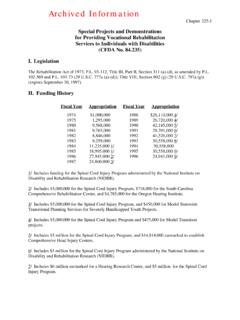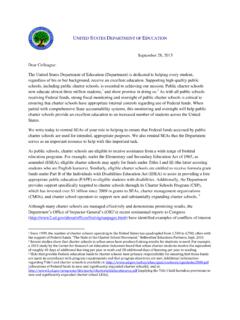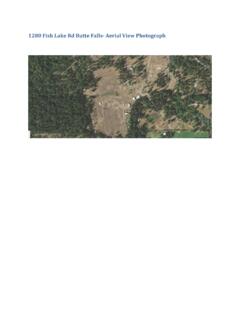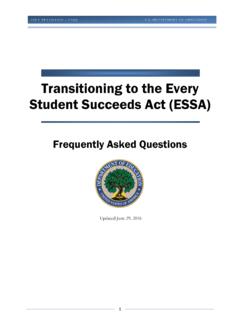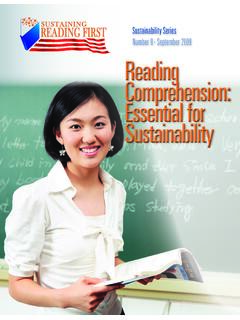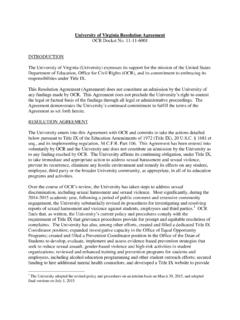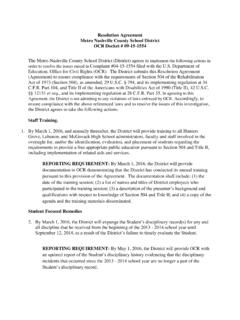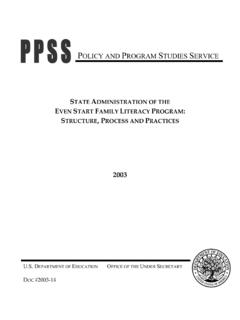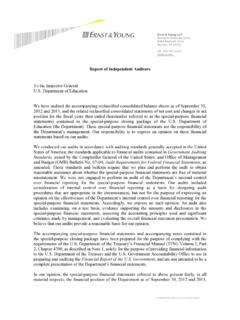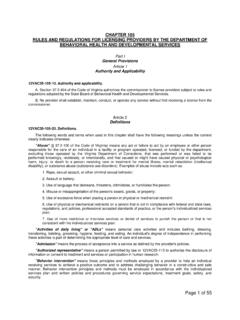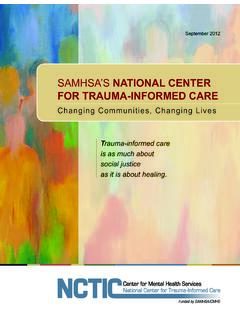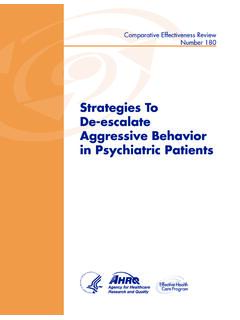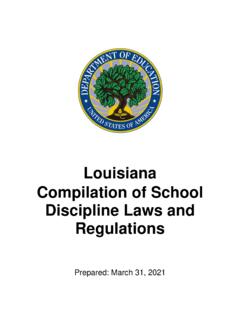Transcription of Policy Statement on Expulsion and Suspension Policies In ...
1 DEPARTMENT OF health AND HUMAN SERVICES DEPARTMENT OF EDUCATION Policy Statement ON Expulsion AND Suspension Policies IN EARLY CHILDHOOD SETTINGS PURPOSE The purpose of this Policy Statement is to support families, early childhood programs, and States by providing recommendations from the Departments of health and Human Services (HHS) and Education (ED) for preventing and severely limiting Expulsion and Suspension practices in early childhood Recent data indicate that expulsions and suspensions occur at high rates in preschool , 3, 4 This is particularly troubling given that research suggests that school Expulsion and Suspension practices are associated with negative educational and life , 6, 7 In addition, stark racial and gender disparities exist in these practices, with young boys of color being suspended and expelled much more frequently than other , 3,4 These disturbing trends warrant immediate attention from the early childhood and education fields to prevent, severely limit.
2 And work toward eventually eliminating the Expulsion and Suspension and ensure the safety and well-being of young children in early learning This joint HHS and ED Policy Statement aims to: Raise awareness about Expulsion , Suspension , and other exclusionary discipline practices in early childhood settings, including issues of racial/national origin/ethnic and sex disparities and negative outcomes for children associated with Expulsion and Suspension in the early years; Provide recommendations to early childhood programs and States on establishing preventive, disciplinary, Suspension , and Expulsion Policies and administering those Policies free of bias and discrimination; Provide recommendations on setting goals and using data to monitor progress in preventing, severely limiting, and ultimately eliminating Expulsion and Suspension practices in early childhood settings; Highlight early childhood workforce competencies and evidence-based interventions and approaches that prevent Expulsion , Suspension , and other exclusionary discipline practices, including early childhood mental health consultation and positive behavior intervention and support strategies.
3 Identify free resources to support States, programs, teachers, and providers in addressing children s social-emotional and behavioral health , strengthening family-program relationships, 1 Early childhood programs or early childhood settings include any program that provides early care and education to young children birth through age five, including, but not limited to private child care, Head Start, and public, private, and faith-based Pre-K/preschool programs. 2 Gilliam, W. S. (2005). Prekindergarteners left behind: Expulsion rates in state prekindergarten systems. New York, NY: Foundation for Child Development. 3 Department of Education Office for Civil Rights (2014). Data Snapshot: Early Childhood Education. 4 Gilliam, , & Shahar, G. (2006).
4 Preschool and child care Expulsion and Suspension : Rates and predictors in one state. Infants & Young Children, 19, 228 245. 5 Lamont, J. H., Devore, C. D., Allison, M., Ancona, R., Barnett, S. E., Gunther, R., .. & Young, T. (2013). Out-of -school Suspension and Expulsion . Pediatrics, 131(3), e1000-e1007. 6 Petras, H., Masyn, K. E., Buckley, J. A., Ialongo, N. S., & Kellam, S. (2011). Who is most at risk for school removal? A multilevel discrete-time survival analysis of individual- and context-level influences. Journal of Educational Psychology, 103, 223 7 American Psychological Association, Zero Tolerance Task Force Report (2008). An evidentiary review and recommendations. 8 It should be noted that a long -standing and continuing practice in Head Start is to not expel or suspend any child.
5 Increasing developmental and behavioral screening and follow-up, and eliminating racial/ national origin/ethnic, sex, or disability biases and discrimination in early learning settings;9 and Identify free resources to support families in fostering young children s development, social-emotional and behavioral health , and relationships. This Policy Statement is part of a series of Federal actions that aim to prevent, severely reduce, and ultimately eliminate Expulsion and Suspension in early childhood settings, and more broadly, to improve school climates and discipline across the educational spectrum. This Statement follows the January 2014 release of the Department of Education s Guiding Principles: A Resource Guide for Improving School Climate and Discipline, which provides recommendations for reducing Expulsion , Suspension , and disciplinary removals in K-12 settings.
6 The Guiding Principles articulated in that practice guide are as follows: Create positive climates and focus on prevention; Develop clear, appropriate, and consistent expectations and consequences to address disruptive student behaviors; and Ensure fairness, equity, and continuous improvement. Although early childhood settings differ in context from K-12 settings, the Guiding Principles are applicable to both, such that focusing on prevention, developing and communicating clear behavioral expectations, and ensuring fairness, equity, and continuous improvement, can and should be applied across settings where children learn. In addition to this Policy Statement , HHS and ED are working together to raise awareness of the issue, encourage State and local Policy development, invest in professional development for the early childhood workforce, disseminate resources to support families, programs, and States, and enforce Federal civil rights law that prohibit discriminatory discipline We want to work toward a goal of ensuring that all children s social-emotional and behavioral health are fostered in an appropriate high-quality early learning program, working toward eventually eliminating Expulsion and Suspension practices across early learning settings.
7 OVERVIEW The beginning years of any child s life are critical for building the early foundation of learning, health and wellness needed for success in school and later in life. During these years, children s brains are developing rapidly, influenced by the experiences, both positive and negative, that they share with their families, caregivers, teachers, peers, and in their A child s early years set the trajectory for the relationships and successes they will experience for the rest of their lives, making it crucial that children s earliest experiences truly foster and never harm their development. As such, Expulsion and Suspension practices in early childhood settings, two stressful and negative experiences young children and their families may encounter in early childhood programs, should be prevented, severely limited, and eventually eliminated.
8 High-quality early childhood programs provide the positive experiences that nurture positive learning and development. 9 ED s Office for Civil Rights and HHS Office for Civil Rights enforce several Federal civil rights laws that prohibit discrimination in early childhood programs receiving Federal financial assistance from their respective departments, including: Title VI of the Civil Rights Act of 1964 (Title VI), 42 2000d - 2000d-7 (prohibiting discrimination based on race, color, or national origin by recipients of Federal financial assistance); Title IX of the Education Amendments of 1972 (Title IX), 20 1681 1688 (prohibiting discrimination based on sex by recipients of Federal financial assistance); and Section 504 of the Rehabilitation Act of 1973 (Section 504), 29 794 (prohibiting discrimination based on disability by recipients of Federal financial assistance.)
9 ED, HHS, and the Department of Justice share authority to enforce Title II of the Americans with Disabilities Act, 42 12131 12134, which prohibits discrimination based on disability by state and local governments, regardless of whether they received Federal financial assistance. In addition, the Department of Justice enforces Title III of the American with Disabilities Act, 42 12181 12189, which prohibits disability discrimination in most private early childhood programs. 10 National Research Council and Institute of Medicine (2000) From Neurons to Neighborhoods: The Science of Early Childhood Development. Committee on Integrating the Science of Early Childhood Development. Jack P. Shonkoff and Deborah A. Phillips, eds. Board on Children, Youth, and Families, Commission on behavioral and Social Sciences and Education.
10 Washington, : National Academy Press. 2 Suspension and Expulsion can influence a number of adverse outcomes across development, health , and education. Young students who are expelled or suspended are as much as 10 times more likely to drop out of high school, experience academic failure and grade retention, hold negative school attitudes, and face incarceration than those who are ,6, 7 While much of this research has focused on Expulsion and Suspension in elementary, middle, and high school settings, there is evidence that Expulsion or Suspension early in a child s education is associated with Expulsion or Suspension in later school Not only do these practices have the potential to hinder social-emotional and behavioral development.
